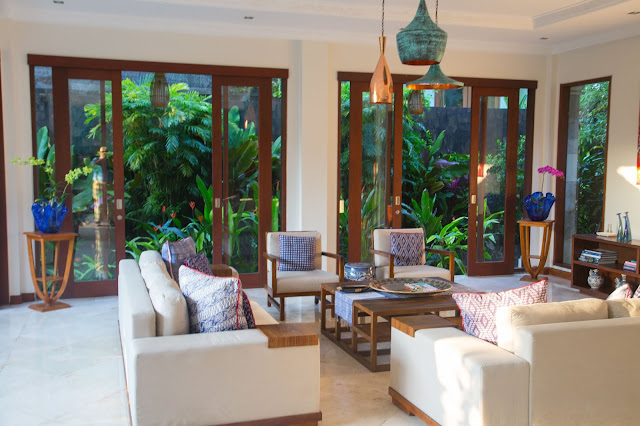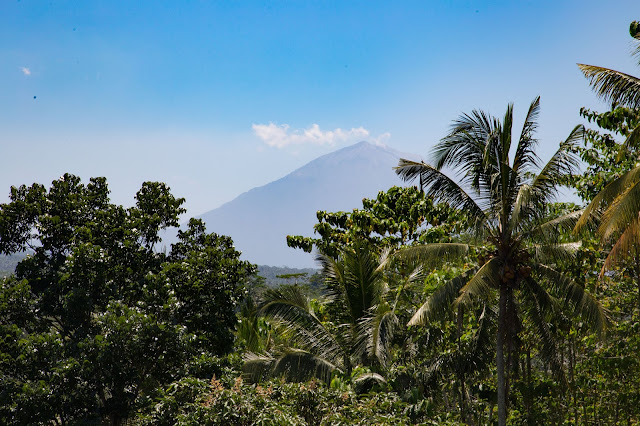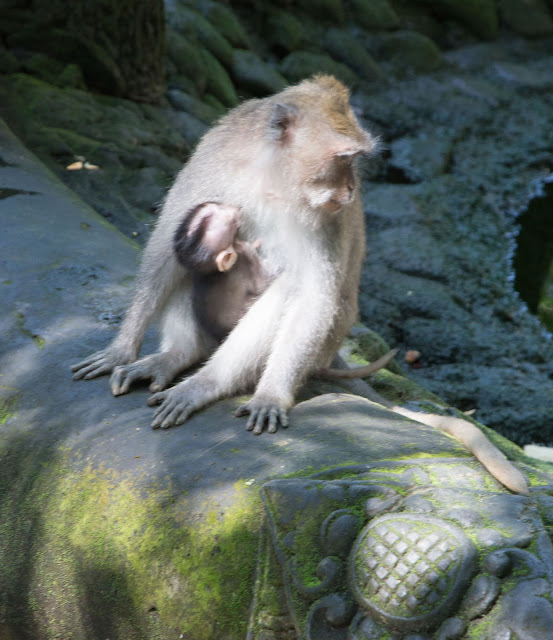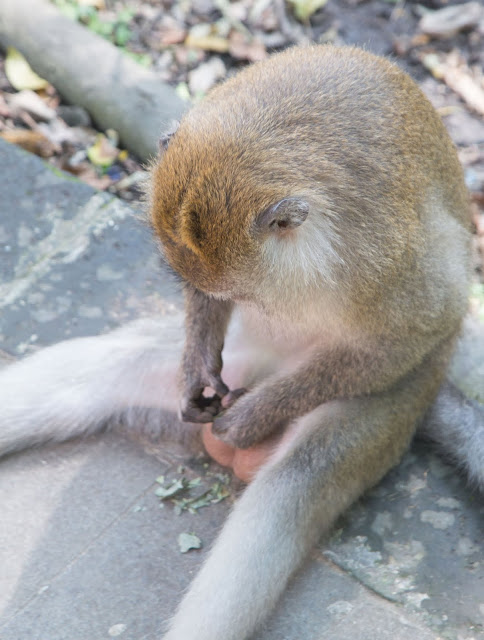In the first installment I awarded Kano Sari 6 stars. What does it take to deserve such a rating? Of course an ideal location matters. The villas abut a tropical forest, ensuring tranquility, but are only a 10 minute walk to Jalah Raya, one of the main streets. Another 10 minutes places you dead center at the corner of Jalah Raya and Monkey Forest Road. Although the hotel will do your laundry for a fair price, if you are feeling ambitious you can exit the hotel, turn right walk fifty feet and have everything ready the next day for 2 to 3 dollars.
Two family run restaurants are on the same street as the hotel. Around the corner is a temple.
Temple statue
The villa was about 900 square feet. The master bedroom opened up on three sides. Singapore is about indoors and structures, Bali is about nature.
Our bedroom. My lens is not wide enough to capture the other wall which also opens up.
The bathroom has a huge tub, and the shower is partly outdoors.
The next criteria is ambience, amenities and attention to detail. Every area was finished to perfection.
Artwork in our foyer.
The grounds added to a sense of peace.
We took our included breakfast, and one dinner by the pool.
Lobby.
Koi pond steps leading to the lobby.
But the secret to a great hotel is the service. Not only was the staff more than ample, but service was with a genuine smile, and questions with real interest. These are lovely people. Then there is the blue phone. I miss the blue phone, bestowed at checkin. One button connects with the lobby. Of course this is handy to have a snack or drink delivered to the room. Similarly. you can request coffee or a drink by the pool. But the real delight is not only will the hotel drive you anywhere in or near town free of charge, but with the blue phone you can request a ride back.
So what is the cost to get into heaven? We booked the 5 night pamper package. This included pick up at the airport, and drop off at our beach hotel in Sanur. The pamper, for each of us, was a one hour massage, a mani and pedi, and a 1/2 day visit to a local spa. The total cost was 11,500,000 idr. That is roughly 755 dollars at current exchange rates. The massage at the hotel rivals the best I have ever had, and my first massage was in 1957.
The tiny town of Ubud may have more spas and yoga studios than the ever indulgent, Beverly Hills. Foot or full body massages start as low as 5 dollars. No doubt Singapore has spas, but be sure to bring your credit card and a letter of reference from your bank. According to The Telegraph (UK), Singapore is the world's most expensive city. Other surveys rate it lower, but prices are very 1st world.
Singapore's Orchard Road peddles Versace, Channel, and a number of names unknown to me, but frenzy inducing for brand name groupies. Of course there is some lower end shopping for less affluent locals, but with little to engage tourists.
But even this lives up to Singapore's legendary obsession with rules, and law and order.
Sign at the Burgis Market.
If you must shop in Singapore, your best bet is ethnic enclaves like Little India. The area true to its heritage, is a good place for gold jewelry, and of course, saris.
Like many 3rd world destinations, Bali is great for shopping. Sarongs, carved wood, silver jewelry and rattan purses are popular choices. If you are staying in Ubud, you need go no farther than the Ubud Art Market at the intersection of Monkey Forest Road and Jalah Raya.
With hundreds of stalls, competition is steep, so bargain hard.
For even more fulfilling shopping, visit the nearby craft villages. Sukawati has an art market similar to Ubud's but with even lower prices. Celuk village is famous for silver. Roslyn bought earrings from this silversmith.
This master carver and his son have a shop adjoining their home. They employ a number of local carvers.
Only masters are permitted to sign their work. We bought one signed, and one much less expensive piece. Lest you think we bargained too hard, here are pictures of the house and grounds.
This is our guide Yuda. He was upbeat and informative.
Yuda gave us a short concert in a music and ceremonial dance area of the house. Yuda also sang in the car. He is better with his hands.
Thinking of Gardens by the Bay, these Joni Mitchell lyrics could certainly apply to Singapore:
They took all the trees
And put them in a tree museumAnd they charged all the people
A dollar and a half to see 'em
Bali has no fancy high rises. It does have unbridled flora.
The flowers in the two pictures above our from Kano Sari
This is the volcano that erupted about a year before our visit.
As with flora, so with fauna. Singapore has an amusement park called Night Safari with a tram ride and shows. Sounds a bit like SeaWorld. We passed.
The Butterfly Park not far from Ubud did charge a small fee, but it was not commercial. No gift shop at the end.
The Monkey Forest is an even greater contrast to Night Safari. It is a sanctuary for the Balinese Long Tail Monkeys, in, and owned by, Padangtegal Village. Monkey Forest is walking distance from central Ubud.
The Ubud Monkey Forest describes its mission, in the visitors pamphlet, as conservation of the area within its boundaries according to the Hindu principle of Tri Hata Karana("Three ways to reach spiritual and physical well-being"), which seeks to make people live harmoniously during their lives. The "three ways" to this goal under the Tri Hata Karanadoctrine are harmonious relationships between humans and humans, between humans and the natural environment, and between humans and The Supreme God. Accordingly, the Monkey Forest has a philosophical goal of creating peace and harmony for visitors from all over the world. It also seeks to conserve rare plants and animals for use in Hindu rituals and to provide a natural laboratory for educational institutions, with a particular emphasis on research into the social interaction of the park's monkeys with one another and their interaction with the park's natural environment.
Quite a mouthful, but the spiritual intent is clear. As with every village in Bali, there are 3 temples one for each of the main Hindu gods. The temples are still in use, open to supplicants and monkeys, but not to tourists.
Statue at temple
This fountain is near the entrance.
Roslyn and Yuda crossing the bridge into the forest.
I found the monkeys irresistible and no doubt have included too many pictures for many readers.
Found mother and child to be too cute.
The staff feed sweet potato to the monkeys 3 times a day.
No explanation needed.
Singapore is not know for native dances, unless you count Ce La Vi disco on the roof of the Marina Sands Hotel.
Worthy of note, Singapore has the highest drink prices in the world.
Bali is know for ancient dance forms. The dancing like that of Cambodia, tells well known stories, but the form is different. Cambodian dancing is smooth, and at times sensuous. Balinese dancing is jerky and angular. Multiple options are available every night. In Ubud the easiest, and most popular, is at the Palace, in the center of town.
Masks are an important part of many dances. In Sukawati, just a few miles from Ubud, is the Setia Darma House of Mask and Puppets.
As much as we enjoyed the dances at the palace, the children's version at Tanjung Sari, our beachfront hotel in Sanur, was even more charming.
This small boy stoled the show.
Part 3 will be about the beach, religion and food.











































































